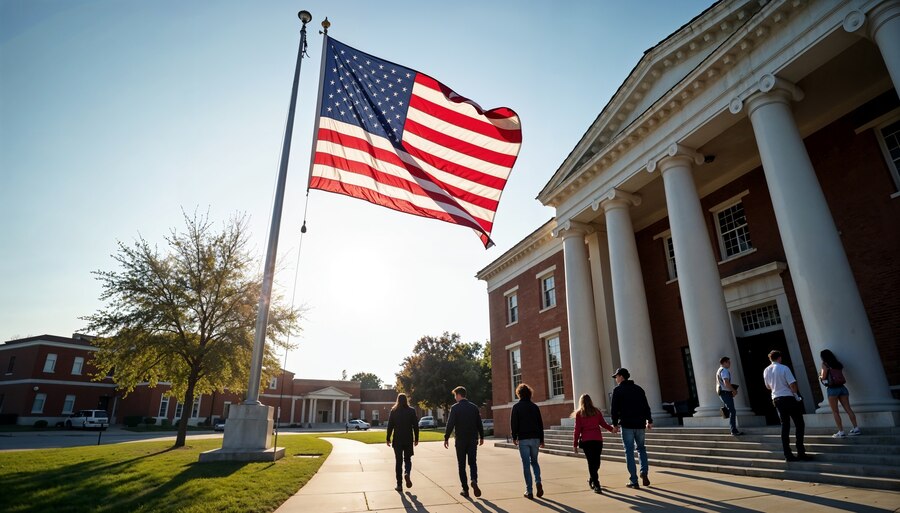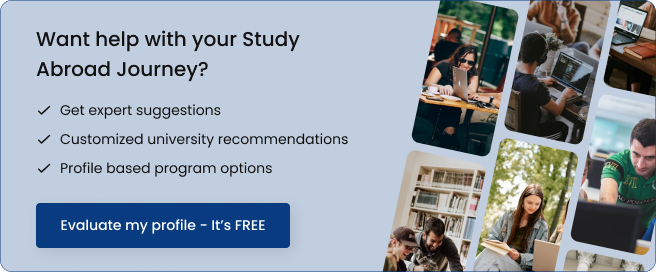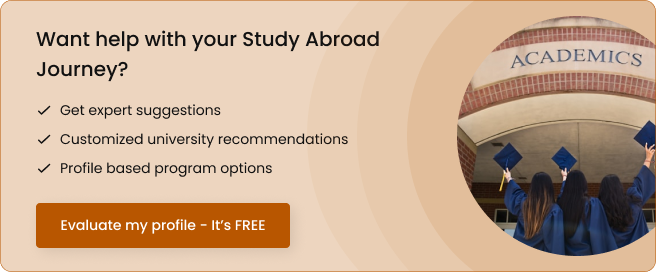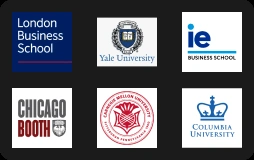
Masters in Finance (MFin) in USA: Everything You Need to Know
Thinking of pursuing an MFin in the USA? You’re not alone! The USA is home to some of the …
Table of Contents

Are you considering pursuing an MBA in the USA? Wondering why it's such a popular choice among international students, especially from India? Let's dive into everything you need to know about studying for an MBA in the USA, from top universities to fees, eligibility, job prospects, and more.
The USA remains the ultimate destination for MBA aspirants, but why? Well, it’s home to some of the best business schools in the world, offering unmatched opportunities for career growth and global networking. Plus, with programs that cater to a variety of needs—be it a fast-track one-year MBA or a traditional two-year program—you have plenty of options to choose from.
Did you know that a significant portion of international students in MBA programs in the USA are from India? This trend continues to grow because of the quality education, career prospects, and opportunities for cultural exchange. But which duration is right for you: a one-year or two-year MBA?
One-Year MBA
Two-Year MBA
So, why should you choose the USA for your MBA over other countries? Here are some key benefits that make it a top choice for aspiring business leaders worldwide.
The USA is home to prestigious institutions like Harvard Business School, Stanford Graduate School of Business, and Wharton, which consistently rank among the best globally. Graduating from one of these top-tier schools can open doors to opportunities worldwide, as employers recognize the rigorous training and expertise you gain here.
Worried about landing a job after your MBA? The USA has a vast job market, with major hubs like New York, San Francisco, and Chicago brimming with opportunities in tech, finance, consulting, healthcare, and more. Companies like Google, Goldman Sachs, and McKinsey actively recruit MBA graduates, offering lucrative salaries.
An MBA in the USA isn’t just about classes; it’s about building connections. You’ll get a chance to network with fellow students, professors, and alumni who are leaders in their fields. Plus, many programs have strong ties with industries, giving you opportunities to meet and learn from successful entrepreneurs and executives.
Looking for a specialized MBA program? The USA offers programs in emerging fields like Artificial Intelligence (AI), Data Analytics, and Sustainability. Schools often update their curriculums to stay current with industry trends, so you can gain skills in the latest technologies and practices.
One big question international students have is, "Can I stay and work in the USA after my MBA?" Yes, you can! Through the Optional Practical Training (OPT) program, MBA graduates can work for up to a year in the USA, and if you’re in a STEM-designated MBA program, you can extend this to three years. Plus, many companies sponsor H-1B work visas, which can be a pathway to long-term employment.
Feeling homesick? Don’t worry! The USA has a rich mix of cultures, and you’ll find thriving Indian communities, especially in cities like New York, San Francisco, and Chicago. There are also student organizations, cultural events, and networks that can help you feel at home and expand your social circle.
Quick Tip: When choosing an MBA program, think about where you want to work after graduation. If you aim to stay in the USA, consider programs with strong local industry connections and robust career support services.

When it comes to MBA programs, choosing the right school is crucial. Here are some of the top business schools in the USA that consistently rank high for their world-class faculty, excellent curriculum, and impressive placement records.
Business School | Location | Specializations | Unique Features |
| Harvard Business School | Boston, Massachusetts | General Management, Leadership | Case method teaching, strong alumni network |
| Stanford Graduate School of Business | Stanford, California | Entrepreneurship, Technology | Focus on innovation, close ties to Silicon Valley |
| Wharton School (University of Pennsylvania) | Philadelphia, Pennsylvania | Finance, Consulting | Leading in finance, extensive global network |
| MIT Sloan School of Management | Cambridge, Massachusetts | Data Analytics, Tech Management | Strength in STEM fields, research-driven |
| Kellogg School of Management (Northwestern University) | Evanston, Illinois | Marketing, Strategy | Collaborative culture, diverse programs |
| Chicago Booth School of Business | Chicago, Illinois | Economics, Finance | Flexible curriculum, known for economic research |
| Columbia Business School | New York, New York | Media, Finance, Consulting | Strong ties to NYC’s business scene |
| Haas School of Business (UC Berkeley) | Berkeley, California | Entrepreneurship, Innovation | Emphasis on sustainability, located near Silicon Valley |
| Tuck School of Business (Dartmouth College) | Hanover, New Hampshire | General Management | Small class size, close-knit community |
| Stern School of Business (New York University) | New York, New York | Finance, Tech, Luxury Marketing | Located in NYC, focus on real-world applications |
Before applying, it’s essential to understand the eligibility criteria for MBA programs in the USA. While each school may have specific requirements, here are some general criteria most top universities look for:
Do you need a specific background to apply? Not necessarily! Most MBA programs accept students from diverse educational backgrounds. However, you do need to have completed a bachelor's degree (or equivalent) from a recognized university. Schools often look for a strong academic record, so aim for a GPA that reflects your commitment and capability.
How important is work experience? Quite a bit! Most top-tier MBA programs in the USA prefer candidates with at least 2-5 years of professional experience. Some schools, like Harvard and Stanford, might admit exceptional candidates with less experience, but having a solid work history can significantly strengthen your application. Executive MBA programs usually require even more experience (often 8-10 years).
Quick Tip: Check the specific requirements of each school to understand how your work experience matches up.
Not a native English speaker? Don’t worry! You’ll just need to prove your English proficiency. Most MBA programs require international students to submit scores from English language tests like TOEFL or IELTS. Generally, a TOEFL score above 100 or an IELTS score above 7.0 is expected.
English Test | Typical Minimum Score |
| TOEFL | 100 |
| IELTS | 7.0 |
Do you need to take the GMAT or GRE? For most schools, the answer is yes. GMAT scores are a standard requirement for many MBA programs, but some schools also accept GRE scores. Recently, many institutions have started offering GMAT waivers, especially for candidates with strong academic backgrounds or significant work experience.
Business School | Average GMAT Score |
| Harvard Business School | 730 |
| Stanford Graduate School | 733 |
| Wharton School | 722 |
| MIT Sloan | 720 |
Quick Tip: Even if a school offers a GMAT waiver, having a competitive GMAT score can boost your application.
What makes you stand out? That’s where your SOP and LORs come in. The Statement of Purpose is your chance to tell your story—why you want to pursue an MBA, your career goals, and how the program will help you achieve them. Schools also usually ask for 2-3 letters of recommendation from individuals who can vouch for your professional abilities.
Apart from the basics, schools often look for leadership potential, problem-solving skills, and extracurricular involvement. Many MBA programs require an interview, where they assess your fit for the program, motivation, and personality. Highlighting any leadership roles or projects you’ve led can set you apart.
Thinking about the cost of an MBA in the USA? It’s no secret that pursuing an MBA here can be a significant investment, but don’t let that discourage you. There are many ways to manage expenses, including scholarships, assistantships, and even loans. Let’s break down the costs and explore funding options.
The tuition fees for MBA programs vary widely, depending on the school and the program's duration. Here’s a look at the average fees for some of the top MBA programs:
Business School | Average Tuition Fees (USD) | Average Tuition Fees (INR) (Approx.) |
| Harvard Business School | $76,000 per year | ₹63,50,000 per year |
| Stanford Graduate School of Business | $77,000 per year | ₹64,30,000 per year |
| Wharton School (University of Pennsylvania) | $80,000 per year | ₹66,80,000 per year |
| MIT Sloan School of Management | $79,000 per year | ₹66,00,000 per year |
| Kellogg School of Management | $78,000 per year | ₹65,20,000 per year |
Note: The costs mentioned above are approximate and may vary. Always check the official websites for the latest fees and conversion rates.
Beyond tuition, living expenses can add up. Here’s a quick comparison of living costs in some of the most popular cities for MBA students:
City | Average Monthly Living Cost (USD) | Average Monthly Living Cost (INR) (Approx.) |
| New York | $2,000 - $3,500 | ₹1,65,000 - ₹2,90,000 |
| San Francisco | $2,500 - $4,000 | ₹2,05,000 - ₹3,30,000 |
| Chicago | $1,800 - $3,000 | ₹1,48,000 - ₹2,45,000 |
| Boston | $2,000 - $3,200 | ₹1,65,000 - ₹2,65,000 |
| Los Angeles | $1,800 - $3,000 | ₹1,48,000 - ₹2,45,000 |
Worried about the cost? Scholarships can help! Many US business schools offer scholarships to international students, including merit-based awards, need-based grants, and even scholarships for specific demographics.
Scholarships for Indian Students There are also scholarships specifically for Indian students pursuing an MBA in the USA:

One of the main reasons many students opt for an MBA in the USA is the promising job market and high salary potential. But what can you really expect after graduation? Let’s explore the trends, average salaries, and key sectors that actively hire MBA graduates.
Which industries hire the most MBA graduates? You’ll find opportunities across a variety of sectors, but here are some of the hottest industries for MBA holders:
Quick Tip: If you’re looking to pivot into a specific industry, consider choosing an MBA program that offers specializations and strong industry connections in that field.
So, how much can you expect to earn after an MBA in the USA? While salaries can vary based on your location, experience, and the industry you enter, here’s a general idea:
Industry | Average Annual Salary (USD) | Common Job Roles |
| Technology | $120,000 - $150,000 | Product Manager, Business Development Manager |
| Consulting | $140,000 - $170,000 | Consultant, Strategy Manager |
| Finance | $130,000 - $160,000 | Investment Banker, Financial Analyst |
| Healthcare | $110,000 - $140,000 | Operations Manager, Healthcare Consultant |
| Retail & E-commerce | $100,000 - $130,000 | Marketing Manager, Supply Chain Manager |
Here are some of the top employers that actively recruit MBA graduates from top business schools in the USA:
Worried about finding a job? Most US business schools have dedicated career services teams that assist students in building resumes, preparing for interviews, and connecting with potential employers. Schools like Harvard, Wharton, and Kellogg even have strong alumni networks that can open doors to job opportunities.
Quick Tip: When researching MBA programs, make sure to look at the career services and placement records. Programs with strong ties to your target industry can make your job search much smoother.
How can Indian students improve their chances of landing a job in the USA after their MBA? Here are a few tips:
A major concern for international students is the ability to stay and work in the USA after completing their MBA. Fortunately, there are several visa options and pathways that can help you gain valuable work experience and even plan for long-term residency. Let’s explore these in detail.
What is OPT, and how does it benefit you? Optional Practical Training (OPT) allows international students on an F-1 visa to work in the USA for up to 12 months after graduation. This period is critical for gaining hands-on experience and building connections in your industry.
Key Points About OPT:
Once your OPT period is over, what’s next? Many students transition to an H-1B work visa, which allows them to work in the USA for up to six years. Employers must sponsor you for this visa, which means they submit an application on your behalf.
Quick Tip: Make sure your employer is willing to sponsor your H-1B application early in your job search process. Not all companies are open to sponsorship, so it’s good to clarify this from the start.
Did you know some MBA programs are designated as STEM (Science, Technology, Engineering, and Mathematics) courses? If you enroll in a STEM MBA program, you can extend your OPT for an additional 24 months, giving you a total of 36 months to work in the USA. This is a huge advantage for international students looking to gain more work experience before applying for an H-1B visa.
School | STEM MBA Specialization | OPT Duration |
| MIT Sloan School of Management | Business Analytics, Data Science | Up to 36 months (3 years) |
| University of Chicago Booth School | Analytics, Technology Management | Up to 36 months (3 years) |
| Columbia Business School | Technology & Operations | Up to 36 months (3 years) |
| Kellogg School of Management | Management Science | Up to 36 months (3 years) |
What if you want to make the USA your long-term home? While the process can be complex, there are pathways to obtaining a Green Card (permanent residency) after your MBA. Many students start on an H-1B visa and later apply for a Green Card through their employer. Here are a few routes to consider:
Quick Tip: Start discussing long-term work visas with potential employers early on. Companies with established visa support programs are more likely to assist you in this process.
Some students wonder if they can skip the GMAT and still pursue an MBA in the USA. The good news? Yes, it's possible! While many top schools still require the GMAT, several programs offer waivers or accept other criteria in place of standardized test scores. Here’s how it works:
Overview of Schools Offering GMAT Waivers:
GMAT Alternatives:
Pros and Cons of Applying Without GMAT:

Planning to stay and work in the USA after your MBA can be a complex process. Let MastersBuddy help you navigate visa options, program selections, and career planning. Connect with us today and take the next step in your journey!

